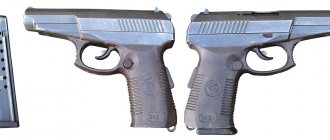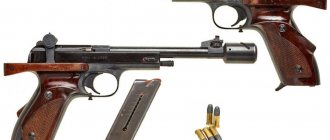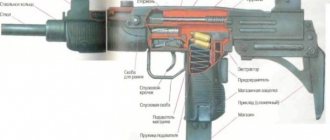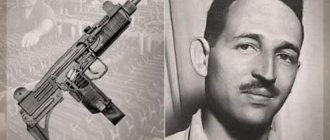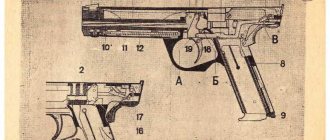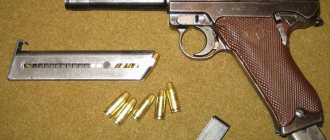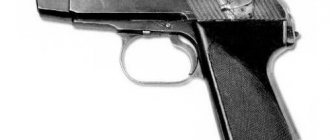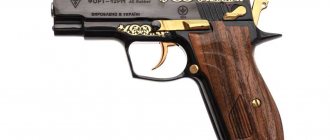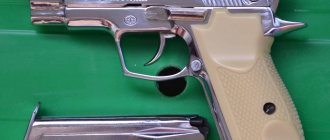PSS pistol, also known as “Vul” from 1979 to 1983, was developed by a team of engineers from the Central Research Institute TochMash, as one of the best options for a silent pistol.
Its main advantage can be called low-noise shooting, which puts the special PS pistol an order of magnitude higher in quality among the S-4M models with other similar characteristics; SME. The weapon also has an increased rate of fire, unlike the above-mentioned samples, due to the unique self-loading design.
History of creation
Development began in 1979, and already in 1983 the pistol became the weapon of representatives of state security and the Ministry of Defense. Among the developers, in addition to the above-mentioned Krylova and Lenchenko, there were also employees of the Klimovsky Central Research Institute "Tochmash" - Levchenko, Petrov, Krasnikov and Medvetsky.
The product was given the designation 6P28 (bP24) and the name “Vul”. The advantages include the small size and special SP-4 cartridges, which allows you to carry it unnoticed and significantly shorten the barrel. Plus, the cartridges have a peculiarity - there is a cutoff of powder gases directly in the cartridge case.
Serdyukov pistol
Serdyukov pistol
The self-loading pistol designed by Serdyukov came to replace the Makarov pistol.
The re-equipment of the special services, and it is in these units that SR1MP “serves”, is dictated by updated means of protecting criminals.
The striking power of the PM cannot compete with the new generation of body armor.
The development of the pistol was completed in 1996; its main feature is the new design of the bullet: the core, which is not completely covered by the shell, retains a charge of kinetic energy when passing through the gun barrel. Such a projectile can easily cope with Kevlar plates in fast-moving combat.
Standard equipment
Due to the unavailability of the PSS-1, its standard configuration can only be judged tentatively.
Therefore, based on the design features and uniqueness of the weapon, we can assume the following set:
The weapon itself
Standard magazine, designed for six SP-4 cartridges, 7.62 mm caliber
Shoulder holster (belt holster for PSS not available), designed for concealed carry.
Gun cleaning and maintenance kit.
Features of the use of the presented weapons
These silent pistols are used by the army and special-purpose law enforcement agencies. Thanks to its special properties, the weapon is an excellent option for carrying out sabotage or liberation operations. It is used most often in cases where the enemy cannot be reached with a knife or if it is impossible to use another weapon. The fact is that the gun does not produce noise or fire flash and is light in weight.
It should be noted that such weapons are not issued to standard police or army units. A pistol of this type does not require a silencer, and this makes its use as convenient as possible.
Operational and technical characteristics
“Vul” allows for concealed carry and instant use. The handle is a little unconventional in shape, but the hand quickly adapts to it. The fuse box does not cause any difficulties during work and training. The only big drawback of the pistol is its ammunition - it is still difficult to master in production, and therefore expensive, and the long-lasting excess pressure in the spent cartridge adds negative qualities. But taking into account the specificity of operation, these qualities, as a rule, are not paid attention to.
Performance characteristics
| Length (total) | 170 mm |
| Weapon width | 25 mm |
| Height | 140 mm |
| Height including magazine | 138 mm |
| Cartridge | 7.62x42 SP-4 |
| Rate of fire | 8 rounds per minute |
| Effective firing range | 25 m |
| Lethal bullet range | 50 m |
| Magazine capacity | 6 rounds |
“Rook” Yarygina
“Rook” Yarygina
The design department for the development of the GRAU semi-automatic pistol was headed by Vladimir Yarygin. The 6P35 configuration pistol was named in his honor. It was created on the instructions of the Ministry of Defense with the aim of updating the weapons range of the armed forces and replacing the technically outdated Makarov pistol.
One of the main advantages of the Rook is its high rate of fire with low recoil. Adapted for close combat with 9 mm cartridges.
It is noteworthy that the pistol is suitable for both new magazines, where cartridges are placed in 2 rows, and for older configurations with a single strip of cartridges.
Device and circuit
The Vul trigger is based on the trigger for classic self-loading pistols. The design was modified due to the non-standard type of ammunition. The weapon's automatic operation is based on the blowback principle; the return spring is located outside the guide tube above the barrel.
The return spring is under the chamber, followed by the barrel. The bolt type housing covers the front and top of the weapon. Convenience when gripping the barrel is provided by a rotary type of clamp in the form of a sleeve.
There is also a bolt delay, which allows you to keep the bolt open after all the cartridges have been fired.
The PS pistol has a single-row detachable magazine, designed for 6 PS-4 with side windows.
The fuse is a flag type, there are two positions. Sights are mechanical, open type. You can install a collimator sight on the PSS "Vul" pistol, which allows you to expand the range of use and aim with an open eye, using an aiming mark.
The body of the pistol is metal, goes into the handle with plastic elements, going deep into it behind the magazine shaft
The procedure for incomplete disassembly of the PSS pistol
Holding the weapon by the handle, press the magazine cover into the shaft, then release the magazine latch to remove it. The back of the magazine cover is spring-loaded to facilitate access to the latch, but when the spring wears out, the magazine cannot be locked in the shaft, which causes it to settle and make it impossible to bring the pistol into combat readiness.
Disconnect the safety cock, then, moving the bolt to the rearmost position, inspect the chamber for ammunition. Return the bolt housing to its most forward position, then press the trigger to decock the weapon.
Separate the shutter. Slide the coupling located at the front of the barrel and rotate it 90 degrees. Lightly pulling the bolt up, move the bolt housing to the rearmost position and continue moving to release it.
The silent “Vul” does not have publicly available documentation, maintenance and operating instructions. For this reason, disassembling a weapon by an inexperienced person requires the supervision of more skilled senior personnel.
The procedure for complete disassembly of PSS 1
Carry out partial disassembly.
Unscrew the handle screw and separate the plastic part of the handle, similar to removing the cheeks from the PM.
Dismantling the trigger mechanism has the following features:
Due to the absence of a shutter delay, the trigger spring hook is removed from the left side of the pistol. Due to the absence of shutter delay, this role is assigned to the extractor mirror. To disable the delay at the end of ammunition, you need to change the magazine and cock the hammer by moving the bolt to the rear position.
It is possible to dismantle the trigger only after dismantling the combat mechanics, the body of the reflector is pressed to the right side, with the other hand, remove the trigger by pulling it upward, slightly moving it back, holding the trigger rod, and then release the reflector. To dismantle the reflector, you need to push the stop, then remove the reflector, removing it from the groove in the gun body.
Having released the stop for removing the reflector, move it to the rear side, remove the reflector simultaneously with the spring from the frame channel, and then remove the pusher piston.
Remove the chamber from the body by turning it 90 degrees clockwise and sliding it back. Dismantle the bolt, remove the fuse, firing pin and extractor. Remove the clamp holder rod, then slide the clamp forward, use a screwdriver to move and remove the clamp. Dismantle the bolt spring along with the axis, to do this, press the guide through the hole in the rear of the bolt with the rod of a screwdriver, move the lock to the muzzle of the weapon, remove it from the grooves, and then smoothly reduce the pressure on the spring.
Disassemble the magazine by pressing the spring towards the feeder and sliding the magazine cover forward.
The pistol is reassembled in the reverse order.
During the complete disassembly and reassembly process, it is worth remembering the following important points:
Fix the chamber upward with the number, the groove is only for the tooth of the pusher element located at the rear and below. When installed in the upper part of the frame, the tooth should “look” upward. When fixing the spring with a stop in the pusher part in the groove of the stop. The mainspring is plate-type, two-leaf, identical in structure to the PM spring, however, there are increased power qualities.
Storing the Vula causes the polyamide handle to shrink, which creates a problem when removing the same magazine. In such cases, it is necessary to periodically grind down the internal planes of the magazine shaft with a flat file.
Disassembly and cleaning
Special forces weapons. Special self-loading pistol (PSS)
Bringing the PSS pistol to normal combat
horizontally: the rear sight is shifted to any side, while a shift of 0.1 mm leads to a deviation of the MTP (midpoint of impact) on the target to the same side by 20 mm; vertically - the rear sight from the spare parts and accessories set is replaced, but an element of a different selectivity group leads to a change in the position of the STP by 60 mm.
When shooting at 25 meters STP group of 4 holes, a deviation of more than 75 mm from the control point located 12.5 cm above is not permissible.
Acquaintance
PSS is a Soviet hand-held special weapon.
Unlike the PB (silent pistol) produced in 1967, it is more compact. The PSS is a model that, thanks to the use of special SP-4 cartridges, in such a parameter as rate of fire, is superior to the Soviet silent double-barreled pistol S4M produced in 1960 and the small-sized “Groza” (MSP) produced in 1965. In the PSS, the bullet is pushed out of the barrel channel not by powder gases, but by a special piston. In the technical documentation, the weapon is listed as 6P28. PSS (self-loading special pistol) is used by employees of various Russian intelligence units.
Modifications
The PSS Vul pistol - has a unique design and minimal noise when fired without the use of PBS - became an incentive for the creation of a different small arms design with high-quality parameters. Such designs include the PSS 2 pistol.
The creators' task was to create a pistol with high combat characteristics, which was based on the use of the SP-16 7.62x43 mm cartridge. For this cartridge, an elongated type of sleeve is provided, which makes it possible to increase the amount of gunpowder charge. Accordingly, the initial speed of the bullet increased from 200 meters to 300 m/s.
The charge for PSS 2 is a steel bullet with a reduced diameter at the head. The charge is equipped with a leading copper belt, the head is sharpened to increase penetration properties.
The PSS-2 complex allows you to confidently hit targets, penetrating body armor of the 2nd protection class at a distance of up to 25 meters.
The PSS 2 pistol has a metal frame equipped with a rifled barrel, behind which the bolt casing and automatics are located.
The handle is at the bottom, there is also a magazine, and trigger brackets. The PSS 2 uses a movable chamber and a free-type bolt. Above the barrel is a bolt with a return spring and a guide rod. The chamber has a spring in the under-barrel part of the structure.
The rear zone of the metal frame is where the trigger and elements for feeding cartridges are located. The PSS 2 pistol does not have a bolt casing for the entire length of the pistol, which is why there is no extractor window for spent cartridges.
Silent pistol PSS Vul 1983 Russia
The self-loading special pistol “Vul” was improved by the developers in 1983 and still has no analogues in the world. The advantages of weapons include:
- small size;
- noiselessness;
- ease of storage and operation;
- simple design;
- the ability to equip with an optical sight;
- tangible fire power;
- low cost in the design and manufacture of 6P28.
No army in the world has similar weapons with such performance characteristics. Its small size and the ability to quickly bring it into combat put the PSS on par with specialized weapons.
Why does the PSS fire completely silently?
The MSS does not use any standard sound suppression technology. Compact in size and light in weight, the Vul is completely silent. The designers of the pistol (V. Levchenko and Yu. Krylov) managed to achieve this through the use of a special type of ammunition - modification SP-4. Its operating principle is based on a technology in which powder gases remain inside the cartridge case at the moment of firing. In this case, the rod that pushes the bullet blocks their access, and since the noise is produced directly by the gases expanding in the air, the SP-4 shot is completely silent. The only noise from the PSS is the sounds made by its moving parts and when the bullet hits the target.
Although the Vul is quite simple in appearance, its internal structure is well thought out. For example, its non-fixed chamber with a return spring. At the moment the bullet hits the rifling, the chamber, together with the sleeve, opens the barrel from the reverse side. This way, a zone of low pressure is not created in the channel, so the bullet fires without the characteristic pop. Then, on the reverse stroke, a special part of the chamber slightly grips the rearward bolt, minimizing the sound from its contact with the pistol frame.
In service
S-125 operators
- Azerbaijan - up to 54 C-125-2, as of 2016
- Algeria - a number of S-125 and S-125 "Pechora-M", as of 2016
- Angola - 12 C-125, as of 2016
- Armenia - about 20 S-125 and S-125 "Pechora-2M"
- Belarus
- Bulgaria - in service as of 2016
- Venezuela - a certain number of S-125 Pechora-2M, as of 2016
- Vietnam - a number of S-125-2TM air defense systems, as of 2016
- Georgia - in 2008, Ukrainian S-125s removed from combat duty were transferred to Georgia.
- Egypt - more than 212 Pechora-2M units, including a number of S-125-2TM, as of 2016
- Zambia - 3 S-125 batteries, as of 2016
- India - 25 divisions of the Pechora-M air defense system for 2016
- Yemen
- Kazakhstan - 18 modernized S-125 Pechora-2TM air defense systems and several dozen S-125 air defense systems
- Kyrgyzstan - 2 divisions (8 launchers) S-125 for 2016
- DPRK - 133 S-125 Pechora air defense systems as of 2016
- Cuba - some S-125s, some mounted on T-55 tank chassis, as of 2016
- Libya - 60 Pechora air defense systems were delivered from the USSR to Libya
- Mozambique - a number of S-125s, probably not operational, as of 2016
- Mongolia - more than 2 units of "Pechora-2M" for 2016 Deliveries were carried out from 2003, and in 2011
- Myanmar - a number of Pechora-2M as of 2016
- Nagorno-Karabakh Republic - unknown number, as of 2022
- Peru - 6 C-125 battalions, as of 2016
- Poland - 17 S-125 SC air defense systems
- Serbia - 6 S-125 Pechora air defense systems, as of 2016
- Syria - some S-125, as of 2016
- Tajikistan - about 16 C-125 for 2016
- Tanzania - a number of S-125s, probably not operational, as of 2016
- Turkmenistan - a number of S-125 "Pechora-2M"
- Uganda - 4 C-125, as of 2016
- Ukraine - a number of S-125 "Pechora"
- Uzbekistan - a number of S-125 and S-125 "Pechora-2M" for 2016
- Ethiopia - some C-125, as of 2016
- South Sudan - 16 C-125 launchers as of 2018
Withdrawn from service
- Cambodia - withdrawn from service in 2005
- GDR
- Finland - withdrawn from service in the 1990s
- Hungary - the air defense system was in operation in 1978-1995
- Iraq - SAM systems eliminated in 2003
- Romania - the air defense system was in operation in 1986-1998
- South Yemen
- Somalia - decommissioned in 1992
- USSR
Russia - withdrawn from service in the 1990s- after the collapse of the state, the air defense system went to the republics that were part of the USSR
- Czechoslovakia
Slovakia - withdrawn from service in 2001- after the division into the Czech Republic and Slovakia, the air defense system went to these states
- Yugoslavia - removed from service, 14 S-125 batteries with 60 launchers were on combat duty
Fashionable looks
When choosing fashionable looks for yourself, you need to pay attention to the palette of recommended shades for the season. The trend is fashionable looks in many interesting shades: blue, burgundy, gray, red, black, blue, orange, green, pink
The leaders remain related and contrasting combinations, total looks.
In casual style - thoughtful carelessness
Suitable for those who love freedom and looseness, value comfort and simplicity in clothing. These are jeans, practical shoes, comfortable skirts, stylish jackets.
Office style
The most successful clothing styles in this style are those that emphasize not a woman’s sexuality, but her elegance and sophistication. Office looks for 2020-2021 are represented by delicate blouses of various styles, cropped trousers, sheath skirts, and impeccable trouser suits.
In a romantic style
Romantic looks can be created by combining bell and pleated skirts with blouses; beautiful dresses with elegant jackets; classic styles can be complemented with various accessories and details.
Minimalism - simple and tasteful
This style is chosen by self-sufficient and confident women. Fashionable images in the style of minimalism do not accept flashy details, multi-colored models, multi-layering, or complex cut variations.
The order of firing a shot from the NRS/NRS-2
| To load the knife, you need to unlock the locking device, turn the barrel and remove it from the knife handle. A cartridge is inserted into the chamber, after which, holding the barrel with the chamber up, it must be inserted into the handle so that its protrusions fit into the corresponding grooves of the firing device box. After turning the barrel, you need to fasten the locking device. Next, you need to cock the trigger mechanism, for which you turn the cocking lever up until it stops and release it. The fuse box must be in the “fire” position. Then you should take the knife in your hands with the blade facing you so that the trigger lever is under the right index finger, the blade is clamped between the palms, and the crosshair rests on the base of the thumbs. The remaining fingers are from below, the fingers of the left hand are on top of the fingers of the right and in no case are on the muzzle. You need to aim using the slot on the crosshair-limiter and the front sight on the end of the handle. The shot is thus fired accurately, the recoil is no greater than when firing from a PSS pistol, and the sound of the shot is quieter, since there are no moving parts in the firing device and the spent cartridge case is not ejected from it. After the shot, it is necessary to remove the barrel from the handle, use the hooks of the crosshairs to remove the spent cartridge case from the chamber (it is heated and pressed by the powder gas to the walls of the chamber). A trained shooter has a weapon reload time of no more than 20 seconds. |
Shop
The Stechkin automatic pistol uses a magazine with an in-line, staggered arrangement of cartridges. It does not protrude beyond the boundaries of the weapon. After the shooting is completed and all ammunition has been used up, the magazine feeder tooth automatically raises the bolt stop. Because of this, it lingers in the rearmost position. As soon as the shooter inserts the magazine, he should press the bolt stop head, after which it will automatically move forward, simultaneously sending the cartridge into the chamber. Note that the trigger will continue to remain cocked.
To prevent the possibility of an accidental shot, the safety box is set to the “PR” position. In this case, the firing pin is pulled back and rigidly blocked, simultaneously blocking the trigger and the bolt itself (the latter in this case is rigidly engaged with the frame). In this way, the Stechkin pistol, the characteristics of which we present, differs significantly from the PM.
When noise effects are not needed
The main strategic goal of the Vula for the 80s was to replace another type of weapon - a pistol with a PB silencer, which was used by intelligence officers and state security services. The PB is not an outdated model; its use is still relevant, but it cannot be called completely silent. Being a standard model with a silencer, a soft pop is still heard when firing.
There are a couple of basic methods to make shots quieter: you can use low-power cartridges with additional attenuation using subsonic bullet speed. In doing so, they actually turn the gun into a “toy shooter.” Or add the length of the silencer itself, in which case the ammunition will be of standard power.
Offensive pistol system
The loudly promoted American pistol Mk.23 mod.0 Offensive Handgun Weapon System has become a classic example of the implementation of the principles of wanting the best, but it turned out as always.”
Initially, as part of the OHWS competition that started in the early 1990s, the American Special Operations Command set very ambitious goals. The new pistol was supposed to have a very significant resource (at least 25 thousand shots), as well as a large lethal and stopping effect due to the use of the .45 ACP cartridge. They expected high reliability in any conditions and shooting accuracy at the level of the best match samples. The package included a quick-release silencer and an under-barrel laser target designator.
The Navunder Pistol competition was won by the Germans from Heckler-Koch, easily finishing on the home field of the Americans from Colt. In 1995, the Mark 23 pistol was adopted with great fanfare... and soon forgotten about.
Mk.23 Mod.0
In fact, the Mk.23 Mod.0 pistol turned out to be a classic example of the fact that the ideas about weapons among those who order them (senior military officials and analysts) and those who then use them (ordinary soldiers) can be very different. With all its advantages, the new American special forces pistol turned out to be huge and too heavy for special operations forces overloaded with weapons and equipment.
Initially, soldiers began to unofficially purchase (often with personal funds) lighter and more compact HK USP .45 Tactical pistols, which, with the same ammunition, weighed 250 grams less and were 25 millimeters shorter in length. In 2004, the US Navy SEAL command purchased lighter “HK USP .45 Compact Tactical” pistols with a magazine capacity of eight rounds. In 2011, the US Navy officially replaced the special forces' Mk.23 pistols with the new Mk.24 (a variant of the Heckler-Koch pistol "HK 45 Compact Tactical").
Heckler-Koch Mk.24 Mod.0
For comparison: the Mk.24 mod.0 pistol with two dozen .45 ACP cartridges in three magazines weighs 1.6 kilos, and the Mk.23 Mod.0 with the same 24 cartridges in two magazines weighs 2.1 kilos. This half a kilo of difference allows a fighter, with an equal load, to have an unstyled “hand grenade” or an “extra” full 30-round magazine for an M4 assault rifle.
Naturally, the list of epic failures when creating special weapons is not exhausted by this trio. What variants of similar epic refusals do you know? Share in the comments!
And you can shoot from the coolest and most reliable weapons used by special forces in the multiplayer game Caliber.” Join us!
About the advantages
According to experts, the strengths of a self-loading special pistol (SSP) include:
- Small size and lightness. Light weight allows the shooter to contain a special PSS pistol in a regular holster.
- Silence. When using this weapon, the fighter does not unmask himself. In addition, during firing, a small amount of flame is knocked out of the muzzle.
- PSS has a simple design.
- Judging by the reviews, the PSS is a weapon that is quite easy to care for and store.
- If necessary, the pistol can be equipped with an optical sight.
- The PSS has impressive firepower.
- The design and serial production of 6P28 does not require large financial investments.
Sources
- https://BusinessMan.ru/pss—eto-chto-takoe.html
- https://PWpn.ru/p-oruzhie/pistolety/pss.html
- https://AkkiHunter.ru/strelkovoe/pistolet-vul.html
- https://ProGuns.ru/pss-vul
- https://tehnowar.ru/260977-Pistolet-dlya-rossiyskih-specslughb-PSS-2.html
- https://www.eg.ru/society/459244/
[collapse]
